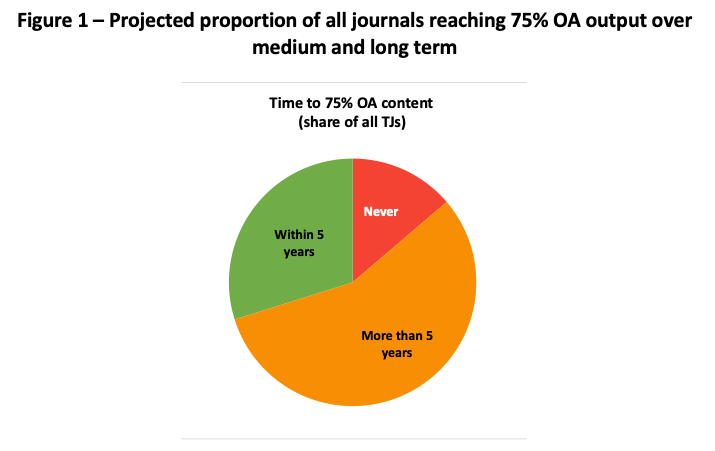News & Views: Transformative Journals – An Experiment in OA Acceleration

In its recent annual update about Transformative Journals (TJs), cOAlition S noted that many journals had not met their targets, for the second year in a row, and were being removed from the list of approved TJs.
Since most journals consistently missed the annual targets, we wondered if the originally included journals, at their demonstrated rates of growing OA content, could have eventually met the goal of 75% open access. Was this a timely move by cOAlition S to cut journals or was it premature?
Background
Transformative Journals are an interim means to comply with Plan S open access (OA) requirements. Publishers nominate hybrid journals and commit to increasing their share of OA output each year, with a view to flipping them to fully OA once they reach 75% OA output. Plan S sets targets for each journal and reviews their performance each year. Those not meeting their targets have their TJ status revoked and no longer qualify for cOAlition S funders to cover their OA fees.
The program started in 2020 and will be stopped at the end of 2024. Our previous analysis of TJs covered requirements in depth and looked at how the journals might grow based on their historic output going into the TJ program. At that time, we noted that the journals’ OA output was growing at roughly half the rate needed for them to keep their TJ status.
Although 56% of journals did not meet their first year targets, they kept their TJ status due to the novelty of the program. However, following its review of the second year of TJs, cOAlition S withdrew TJ status from 68% of the 2,326 journals for failing to meet targets in 2022 and reiterated its commitment to ending the TJ program in 2024. So far just 26, or 1.1%, of the journals in this program have flipped to OA.
How long is long enough for TJs to work?
By combining cOAlition S’s data from last year and this year, and projecting it forward, we can prepare a rough estimate of how long this set of journals would need to reach 75% OA content.

Source: cOAlition S, Delta Think Analysis. © 2023 Delta Think Inc. All rights reserved.
The chart above looks at all the journals in the TJ program, regardless of whether they met their 2023 targets1. It looks at what proportions of them might meet or exceed the 75% OA output “flip to fully OA” threshold over the nearer and longer terms.
- To date 30% of journals have met their targets or will very likely meet them within 5 years from now (2028)
- 56% will take more than 5 years from now
- 14% of journals are unlikely ever to exceed 75% OA output based on current OA growth rates
There are also interesting dynamics within the total program set of journals. More than two thirds of the journals that might reach a flip within 5 years appear to be shrinking overall. Their OA proportions might be rising due to lost submissions for non-OA content, rather than rising demand for OA. The journals that might flip more than 5 years from now (the 56%) look much healthier – they are growing – but 81% won’t reach the 75% threshold until after 2040.
Were the right journals cut?
Using the previously referenced combined dataset and focusing on the journals that are still in the TJ program, we can estimate whether journals might preserve their TJ status in the years to come.

Source: cOAlition S, Delta Think Analysis. © 2023 Delta Think Inc. All rights reserved.
The charts above show whether journals that met their TJ targets in the previous year might meet their TJ targets in the current year.2
- Of the roughly 30% of journals which still have their TJ status in 2023 (or are fully OA already), we estimate that 39% will fail to make their 2023 targets – a large improvement over 2022’s 68% failure rate.
- Then, of the journals that might make the cut (or are fully OA already) in 2023, we estimate that 82% will meet their projected 2024 targets.
- Note, as the numbers of journals reduce, the proportion of the flipped journals will rise by default, and there are some that are already set to flip to OA by 2024.
It appears cOAlition S may have cut the right journals and the right number of journals. They have kept the ones more likely to meet program targets.
Conclusion
Success is always measured by one’s objectives. When looking at the TJ program, evaluating its success depends on what cOAlition S set out to accomplish.
If none of the journals in this program had their TJ status revoked, the program would cover around 9% of the market’s output by 2024. A mass flip at the end of 2024 could have accelerated OA uptake by around two years at current trends. While this isn’t game-changing, it is certainly notable.
We must also remember that cOAlition S didn’t select these journals – they selected themselves. If the goal was to see what kind of uptake was possible and then to see how journals included in a TJ program would perform, this feels like a reasonable experiment. Could a program like this provide another “tool in the toolbox” for accelerating OA? What were the results?
Our previous analysis in June 2021 suggested that journals in the TJ program had historically grown their OA proportions at half the rate they needed to. We may have been slightly pessimistic, but not by much. There has been no significant leap in OA proportions. Over two thirds of TJs have already lost their status, and well under one fifth will make it to the end of the program.
If the real point of the TJs was to encourage flips to fully OA journals, just 3% have flipped (or are due to flip in 2023), and fewer than 30% of TJs are likely to make the 75% OA threshold by 2028. The program appears to have had little effect on OA growth, and cOAlition S sees this slow uptake of OA as justification to close the program (end the experiment?) at the end of 2024 as planned.
It may be that the Achilles Heel of TJs is the small proportion of global output funded by cOAlition S. While Plan S has undoubtedly reinvigorated discussions around OA, publishers take a broader view. For example, just two of the 70 or so TJs that publishers have committed to flip to OA by 2024 are projected to have more than 75% output as OA by that time. It seems the publisher is driving this flip rather than the requirements of the TJ program.
The fragmented, global nature of scholarship remains a key inhibitor to faster OA acceleration. One region’s rules cannot provide a silver bullet to boosting global OA uptake – but they can contribute.
15% (113) of the journals did not have sufficient data to make these projections, so they are excluded for Figure 2B. They are counted as not making their targets in other charts.
2To be consistent with cOAlition S’s statistics, we include flipped journals.
This article is © 2023 Delta Think, Inc. It is published under a Creative Commons Attribution-NonCommercial 4.0 International License. Please do get in touch if you want to use it in other contexts – we’re usually pretty accommodating.













